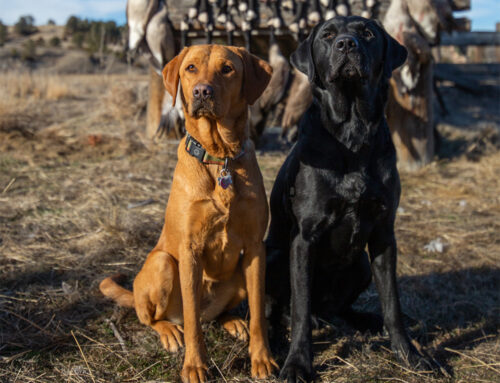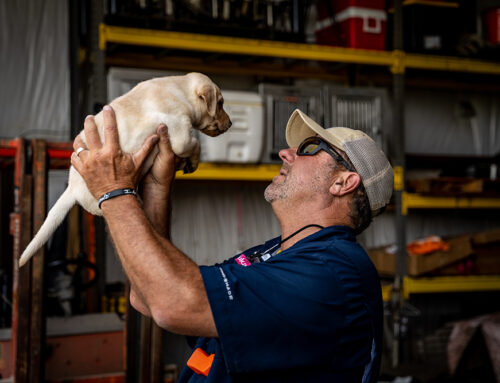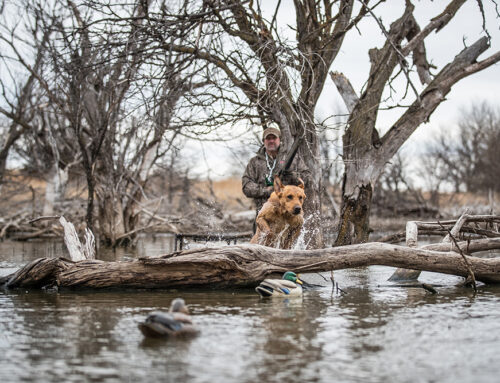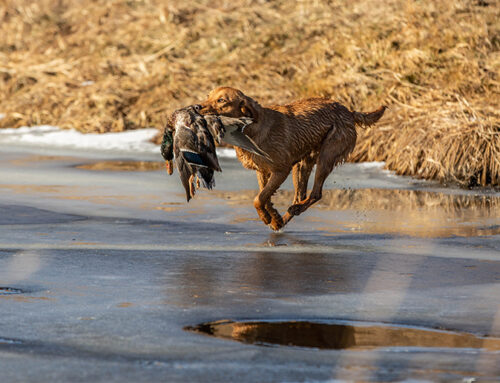Duck Dog Tip of the Week: Ways to Keep Your Lab Fit and Trim

Featuring Al Arthur | Sandhill Kennels
One look at the current trend in food and restaurants, and you’ll gather that most folks love to eat. The same holds true for most animals as well. But if you feed your dog every time he wants to be fed, then you’re doing two things. First, you’re making him happy for just that moment, and he’ll come back again and again. Second, that constant feeding will put extra weight on him, and he’ll be unhealthy for his life. I’ve currently got 32 dogs in my kennel, and that means I need to be efficient when I feed them. Here are a few pointers based on over 30 years of training experience.
Don’t overfeed
My dogs always act hungry, and sometimes they even are. I’ll feed them at the same time twice a day. My feeding program is like a post-work reward. My dogs get a small- to medium-sized portion between 6:30 and 7:00 a.m. That is before their first work session and after they have had time to cool down. Their second feeding is bigger, and it’s between 5:30 and 6:00 p.m. That is after their second work session and after they have had time to cool down. Everyone’s times may be different, but here in the Georgia heat we work early.
Feed them wet
I add water to kibble for two reasons. The first is that it brings out the flavor. But something interesting that I’ve noticed is that the dogs seem to eat wet kibble more slowly. I like that, because slow eating keeps them from getting full before their whole bowl is empty. A second benefit is that the water adds additional hydration to their systems. As mentioned, it’s hot where I live in Georgia, so I want to make sure that all my dogs get plenty of water.
Add regularity to your feeding program
I feed dogs at the same times every day. When those times roll around, the dogs automatically look for their food. But if a dog doesn’t eat his entire bowl, I’ll pick it up. Leaving a partially full bowl down all day long means the dog can eat whenever he wants to. The problem can be serious, especially since handlers will never really know when or how much the dog has eaten. Working a dog with a full stomach can cause a flipped stomach called bloat, and that is a big problem.
If your dog doesn’t eat the whole bowl, pick it up when the regular feeding time is over. Bet on the fact that the next time you put down a food bowl, there won’t be any problem with him eating. If your dog doesn’t eat when you put down the bowl you might need to consult your vet.
Determine your dog’s proper weight
There are a lot of different tables and recommendations about how much to feed your dog. They’re a good start. But it’d be a part-time job to maintain a chart of each of my 32 dogs’ weight and the number of cups of food they each need to eat per day. Years of experience allows me to use a visual approach. I look for muscular definition in every dog’s chest and legs whenever he stretches or flexes. Seeing ribs is fine on an English pointer, but I don’t want to see ribs on a Lab. It means they’re probably too skinny. To find the balance, I look to see an outline of the ribs.
Another good indicator of weight is their post-workout reaction. Fit dogs drink water and stand up on stake-outs or walk around in their kennel runs. Dogs that drink a ton of water and then lie down and pant don’t have enough endurance. Part of their lack of endurance may come from not enough regular work, but it can also come from feeding the wrong amount of food. Too little is as bad as too much.
During both the season and the off season, dogs in my kennel are worked every day. Some are run to increase their endurance, while others work marks and retrieves. I’ll determine how much to feed them based on their workload. The harder I work them, the more they need to eat. The problem usually comes when my training is done and I send them home to their owners. If their owner feeds them the same amount I do, but doesn’t work the dog as much, the dog can put on weight. If you’re not working your dog a lot, then he’ll need to eat less. If he’s working hard on a regular basis, he’ll need to eat more.
Labs need energy to perform well whenever they are working. If they’re eating too much, then they become overweight. That extra weight forces them to work harder. It taxes their organs and skeleton, too. Keep your dogs at the proper weight, and they’ll give you all they’ve got every day.







Leave A Comment